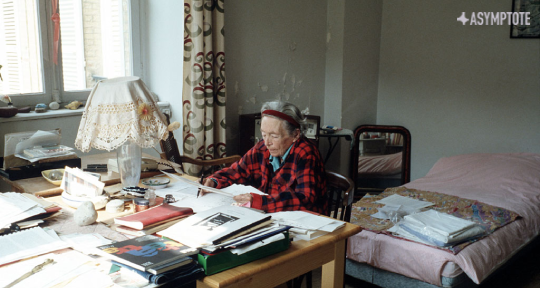Renowned French writer Marguerite Duras published, amongst many highly regarded novels, plays, and screenplays, a fascinating text about the art of writing. Écrire (Writing), published in 1993, is a series of fragmented meditations on her experience of writing and what impels her to do it. Duras takes the reader into her confidence, tracing the complexities and contradictions of her artistic practice that leads to a profound reflection on the limitations of the written word. In this essay, Georgina Fooks, Asymptote’s Social Media Manager, explores Duras’s philosophy of writing laid out in Écrire, and considers how her thoughts on writing’s inherent contradictions and limitations might also be applied to translation practice.
Writing and translating could be described as sister arts. Writers become translators, and translators become writers. After all, what is writing but the translation of ideas, experience, and memory onto the page? As writer-translators, we might seek guidance and models to follow—a way out of the text to be translated, or a way through.
One writer I turn to again and again to help navigate the complex threads tying together reading and writing—both so key to a sustainable translation practice—is Marguerite Duras, the celebrated French writer and experimental film-maker. Best known for The Lover (a hybrid work that is best described as fictionalised autobiography, which won the 1984 Prix Goncourt), her oeuvre is distinctive, addressing themes of desire, loss, and death, in a style that can be repetitive, sparse, but striking all the same.
Duras enjoys a certain infamy as a public figure in France—born in French Indochina (modern-day Vietnam) in 1914, she moved to her parents’ native France at aged seventeen. During World War II, she was a member of the Communist Party and of the French Resistance, alongside François Mitterrand (who later became President of France). Her husband was deported to Buchenwald, the notorious concentration camp—an experience she later drew on for her work The War. Later in life she was a notorious femme de lettres, known for her alcoholism and at times controversial opinions, as well as her literary success.
Duras never wrote directly about the art of translation, but her work does testify to an interest in foreign languages. Non-Francophone names populate her work, as in The Ravishing of Lol Stein, whose protagonist Lol V. Stein falls in love with Michael Richardson and frequents S. Thala and T. Beach. This interest in language as a tool and practice is evidenced in her essay on writing, Écrire, a reflexive piece that provides fruitful new ways of thinking about translation as a mode and as a discipline. It’s a piece full of contradictions—thought-provoking statements that lead us towards a Durassian conception of writing and style, which is in turn fruitful for our thinking about the arts of reading and writing, and their impact on translation. READ MORE…

